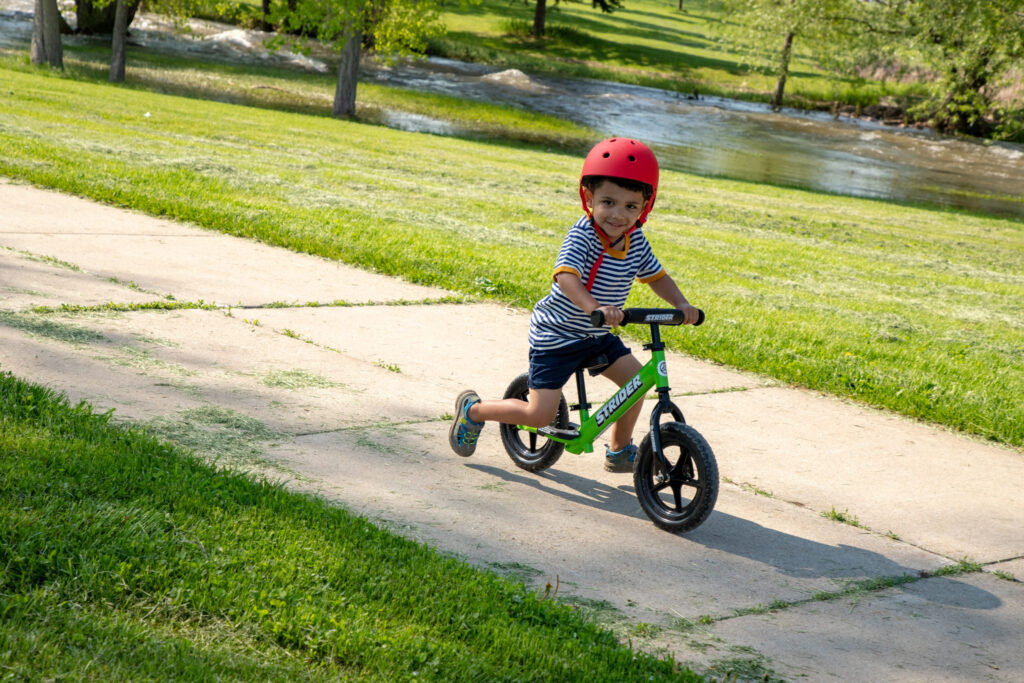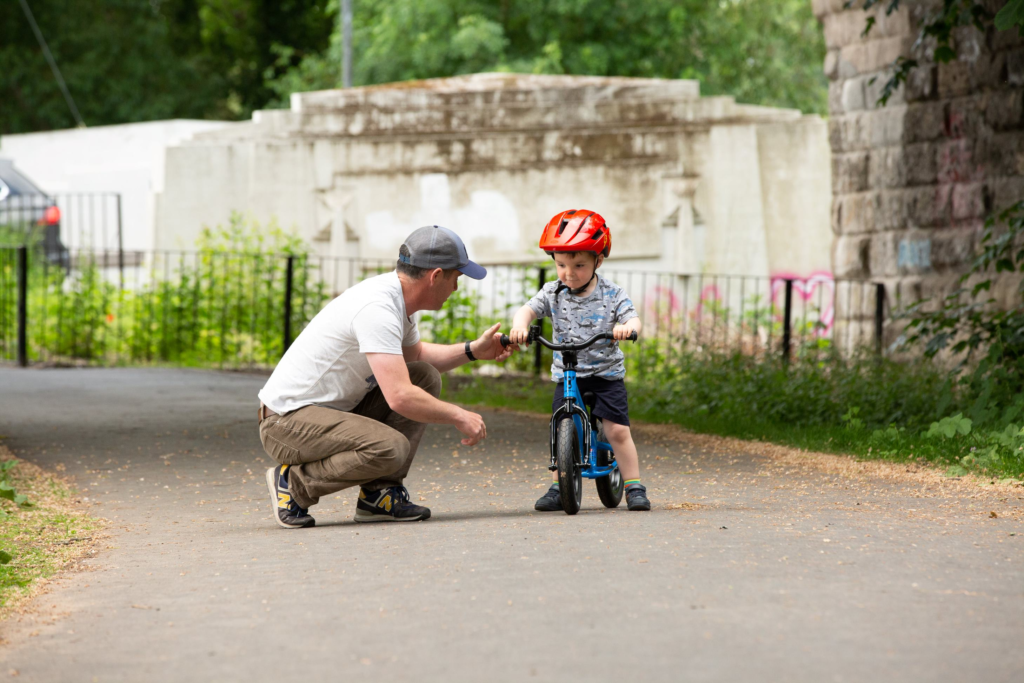Welcome to the Topic “Tips For Getting Your Child Started on Their Balance Bike”
Parents frequently inquire as to the most effective method for getting started on a fresh balancing bike. Some children will take to riding a balancing bike right away, much like a baby bird that is first learning how to leave its nest, while others might want additional assistance and motivation at first.
WHAT IS A BALANCED BIKE?
The Dandy Horse, which was created by Karl Drais in 1818, was the first mode of transportation for humans that utilized two wheels. The Dandy Horse served as the model for the modern bicycle. In spite of the fact that it was constructed out of thick lumber and wrought iron, had enormous wheels, and was designed more for adults than for children, the theory behind the balancing bike was quite similar to what we have today.
A balancing bike is normally meant to be a child’s first bike and can be used starting at the age of 18 months and above.
The youngster pushes off the ground with their feet, initially walking and then running, and progressively increasing their stride until they can glide along with their feet up. The saddle is lovely and low, and there are no pedals to get in the way. When children have mastered their balance bikes, they are able to ride at alarmingly fast speeds and are readily able to compete with pedal cycles for the same amount of money. Put on your brakes if you can!
Balance Bike Over a Standard Pedal Bike?
Because balancing bikes are able to tilt flexibly from side to side, they are beneficial for helping young riders develop their balance, coordination, and motor abilities. Kids are able to concentrate on the skills that are far more important and challenging, such as starting, balancing, steering, and stopping, when the task of pedaling is removed from the equation. Children can easily go from a balance bike to a pedal cycle without the aid of stabilizers if they master these fundamental abilities first (training wheels).
Children gain the self-assurance they need to move quickly and independently when their feet are planted firmly on the ground. They will reflexively bring their feet down to slow the bike down at the first sign of difficulties or any wobbles in the bike’s handling.
Because of the lack of complexity in a balance bike, it is both robust and lightweight, which enables it to be easily pushed, lifted, and maneuvered. Because they do not have a greasy chain, they may be simply transported and stored in the trunk of a car.
Why Not Use a Tricycle or A Bike with Stabilisers?
Stabilizers teach children to ride with their bikes upright, which teaches them harmful behaviors that they will need to unlearn once the stabilizers are removed. Steering a bicycle is accomplished by tilting the handlebars, as shown in the following video. Yes, it is true that the vast majority of us learned how to ride a bicycle on a regular bike equipped with stabilizers; however, with the development of the balancing bike, we can expect that it will soon be a thing of the past.

Online Search Trends for Balance Bikes
It is apparent that cycling is as popular as it has ever been, given that global sales of children’s bicycles are expected to reach about $5 billion by the year 2025. The epidemic caused a significant increase in demand for bicycles all across the world, and the introduction of innovative e-bike technology has piqued the curiosity of an entirely new group of people.
It is difficult to obtain accurate global sales figures for balance bikes; nonetheless, trends in search data indicate that balance bikes are also becoming more popular every year when compared to other types of cycling training.
The Future of Balance Bikes
Since Rolf Mertens constructed the first wooden Like-a-Bike, balance bikes have come a long way since that time. What was once considered to be “quirky” are now universally acknowledged as the ideal sort of little bike for establishing good balance and coordination skills in children. [Citation needed] [Citation needed] [Citation needed]
Of course, there are some people—mostly adults—who continue to think of balancing bikes as being a little bit “strange.” It’s possible that this is a generational problem, especially considering how many people who came of age in the 1970s, 1980s, and 1990s didn’t even know what a balancing bike was, let alone ride one as a kid.
On the other hand, the statistics show that an increasing number of children are learning to ride bicycles without the assistance of training wheels or stabilizers and are doing so by balancing bikes. As a consequence of this, students are acquiring new abilities that will serve them well, not just in riding but in a wide variety of other activities as well. Because of this, it is expected that interest in balance bikes will continue to grow over the next few years, particularly when new designs and technology are developed.
Pick A Safe, Suitable Location
Your youngster will be more likely to pay attention to the activity at hand and stay out of harm’s way if they are instructed in an open space that is free from distractions such as traffic.
It is important to steer clear of any and all obvious obstructions, such as parked automobiles, steps, open water, and so on. Your youngster will be able to gather enough momentum to balance safely if the surface they are walking on is tarmac or short, dry grass.
Choose the Right Bike
It is said that a terrible worker will always point the finger at his tools, but the reality is that a defective bike can make it much more difficult to pedal, which may discourage your youngster from continuing to do so.
Your youngster will have all the tools at their disposal to begin cycling in earnest if you invest in a good, lightweight balance bike for them. Make sure the tires have enough air in them, that the wheels can spin freely, that the handlebars can be turned smoothly, and that the brakes, if the bike has any, are functioning properly.
Perfect Fit
Your child’s knees should be bent slightly, and they should be able to touch the ground with the balls of their feet while they are seated on the saddle.
In order for your youngster to have an easy time navigating, the handlebars need to be within comfortable reach but not too close together. On proper bicycles, the handlebars can be rotated either backward or forwards and moved either up or down to provide the perfect fit.
No Stabilisers Are the Key to Perfect Balance
Do not install stabilizers on your child’s bike when they are ready to pedal it if they have previously ridden a balance bike because this will undo all of the wonderful work they have done in learning to balance. It will be detrimental to their growth, similar to the effect of giving a toddler who is just learning to walk a cane or crutch.
Practice Makes Perfect
Even modest amounts of daily practice, such as five or ten minutes, can result in significant gains. Additionally, the more skillful your youngster becomes, the more they will want to go outside and ride their bicycle.
Get Padded Up
It is advisable to have your child wear the appropriate gear so that even a minor fall will not cause them to lose their self-assurance. Along with sturdy shoes and gear, such as trousers and a soft-padded jacket, it is strongly advised that you wear a helmet that is well-fitted, as well.
Find A Gentle Hill
Find a fairly soft downhill that will help your youngster gather up speed in order to get them coasting along comfortably. This is the ideal way to get your child moving. Just make sure there’s enough space for water to drain out at the bottom!

Learn to Use the Brakes Properly
At least in the beginning stages of their use of the balance bike, the vast majority of children will naturally utilize their feet to stop when they need to. When your child begins to pick up more speed, it will be necessary for them to begin using their brakes. It is in everyone’s best interest to begin by instructing them in the use of the rear brake, then progress to the front brake as they become more self-assured. If they feel the need to slow down or stop, you should probably keep your hand on their back while you run alongside them.
Patience Really Is a Virtue
In most cases, mastery of balance comes rather rapidly. On the other hand, the intricacies of pedaling and stopping can take more time.
If your kid is hesitant to start riding a bike, it’s probably best to keep it away in the garage or shed for a few weeks until they’re mature enough to handle it.
It may be possible to motivate your youngster to ride their bike by installing some fun additions on it, such as bells, stickers, or even a basket.
Monkey See, Monkey Do
Your child will attempt to imitate whatever it is that they see you doing, so it is in their best interest to watch you ride a bike as much as you can. If they have a sibling or sister who also rides a bike, that is excellent news because you will be able to go out and ride together as a family, which is exactly what it’s about!
Are you looking to get a bicycle for your kid at the moment? Put an end to your search since the savior that you’ve been seeking—WudeBike—has finally made their appearance. Due to the fact that they are experts in balancing bikes, kid bikes, BMX bikes, as well as a few other forms of bikes and parts, they are the most dependable source of bicycles. Check out all of the incredible choices they offer on their website by going there.
Have any questions regarding the topic “Tips For Getting Your Child Started on Their Balance Bike” feel free to comment below.
Also Read: Best Balance Bikes for Kids of All Ages
